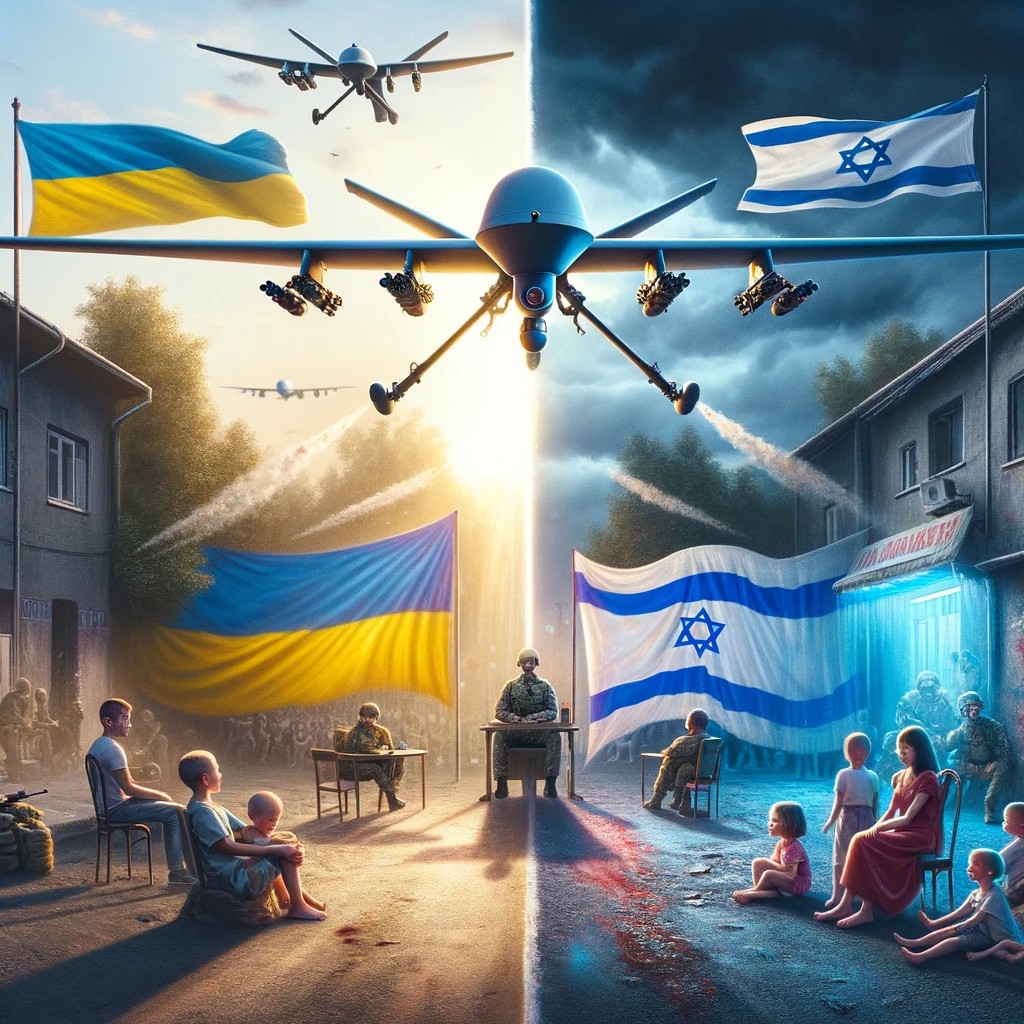In a groundbreaking development that could reshape the course of the ongoing conflict, Ukraine has turned to artificial intelligence (AI) to enhance the capabilities of its drone fleet. The use of self-teaching targeting algorithms in nimble quadcopter drones has become a critical response to Russia’s deployment of electronic warfare (E.W.) equipment, threatening Ukraine’s drone operations. As Russia intensifies its 22-month-long war on Ukraine, the clash between traditional military strategies and cutting-edge AI technologies takes center stage, marking a pivotal moment in the evolving landscape of modern warfare.
On the other hand, Israel’s utilization of artificial intelligence to enhance target selection for air strikes raises substantial concerns among A.I. skeptics and human-rights advocates. Experts allege that Israel is intentionally deploying AI to target civilians, raising profound ethical concerns about the deliberate use of such technology in conflict zones and the tragic consequence of thousands of innocent children and women losing their lives.
In this context, Israel’s A.I.-driven air strikes pose an elevated risk of further jeopardizing the lives of civilians in Gaza. If Israel’s air-strike algorithm epitomizes the darker side of military A.I., a striking contrast emerges with Ukraine’s drone-steering A.I., representing the lighter side. While Israeli A.I. initiatives raise concerns about collateral damage, the Ukrainian A.I., in aiding defense against Vladimir Putin’s forces, holds the potential to safeguard innocent lives. This dichotomy underscores the complexity inherent in the A.I. revolution, particularly within the context of warfare, where the same technological advancements can yield contrasting consequences.
Ukraine’s AI drones – Overcoming electronic warfare challenges
The strategic advantage initially held by Ukraine in the realm of robotics, especially in its drone operations, faced a significant challenge with Russia’s deployment of radio-jamming electronic-warfare gear along the front line. These jammers posed a direct threat to the first-person view (FPV) drones, disrupting the crucial communication link between operators and their explosive-laden drones.
Recognizing the vulnerability introduced by electronic jamming, Ukraine’s drone developers are actively working on an AI solution – a self-teaching algorithm designed to quickly identify and lock onto a drone’s target. The aim is to enable the AI to seamlessly take control in case of signal loss due to jamming, ensuring precise strikes even under adverse conditions.
Twist Robotics, a Ukrainian company, has taken a significant step forward by successfully testing a drone-targeting algorithm. This innovation, according to Rostyslav Olenchyn, co-founder of Twist Robotics, allows the drone to be guided by the AI system after the target is locked.
The Evolution of Drone Warfare in the Ukrainian Conflict
In the initial stages of Russia’s aggression, Ukraine’s strong tech sector and close ties to high-tech industries gave them a significant advantage in drone warfare. The Ukrainian air force’s advanced TB-2 drones wreaked havoc on advancing Russian formations, demonstrating the effectiveness of their drone capabilities.
As the conflict transitioned to a more positional phase, Ukraine adopted a drones-first strategy, relying heavily on small FPV drones. These lightweight drones, carrying a pound or so of explosives, became the weapon of choice for Ukrainian brigades, compensating for shortages of heavy artillery.
In the hands of skilled operators, FPV drones proved to be deadly weapons, with the Birds of Magyar drone group claiming significant success in striking and destroying Russian vehicles. Ukrainian President Volodymyr Zelensky’s commitment to building a million FPV drones underscores their strategic importance.
AI assistance – Navigating the challenges ahead
Recognizing the threat posed by Ukrainian FPV drones, Russia deployed the RP-377 radio-jammer, creating a drone-proof bubble around vehicles. While the RP-377 had limitations in range, newer and more advanced jammers, like the Volnorez, raised concerns about the sustainability of Ukraine’s drone advantage.
To maintain their edge in drone warfare, Ukrainian forces are exploring the integration of AI into their operations. The proposed AI system would learn to recognize targets through the drone’s camera, allowing it to continue steering the drone toward the target even in the absence of a radio link.
As Ukraine embraces AI-assisted drone controls, questions arise about the potential costs and ethical implications. While the cost of retrofitting drones with AI could rise, the Ukrainians face a crucial choice between adapting to new technologies or surrendering a vital battlefield advantage to Russia.
As the conflict in Ukraine enters a new phase characterized by the integration of AI into military operations, the world watches closely to understand the implications of this technological shift. Can AI-assisted drones help Ukraine maintain its advantage against the evolving tactics of the Russian military?
The intersection of warfare and artificial intelligence raises complex questions about the future of armed conflicts and the ethical considerations surrounding AI in military applications. Israel’s misuse of technology for its crimes against humanity has also triggered the fact that it has been challenged in the International Court of Justice, underscoring the gravity of the ethical and legal dimensions surrounding the intentional targeting of civilians.
At the same time, as Ukraine pioneers the use of AI in its defense strategies, the global community must grapple with the challenges and possibilities that arise when man and machine collaborate on the battlefield. Will AI prove to be the game-changer Ukraine needs, or does it introduce a new set of risks and uncertainties to the already complex landscape of modern warfare?


